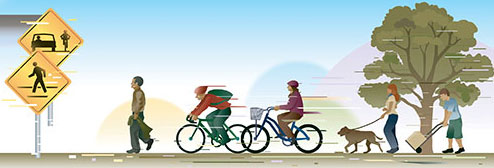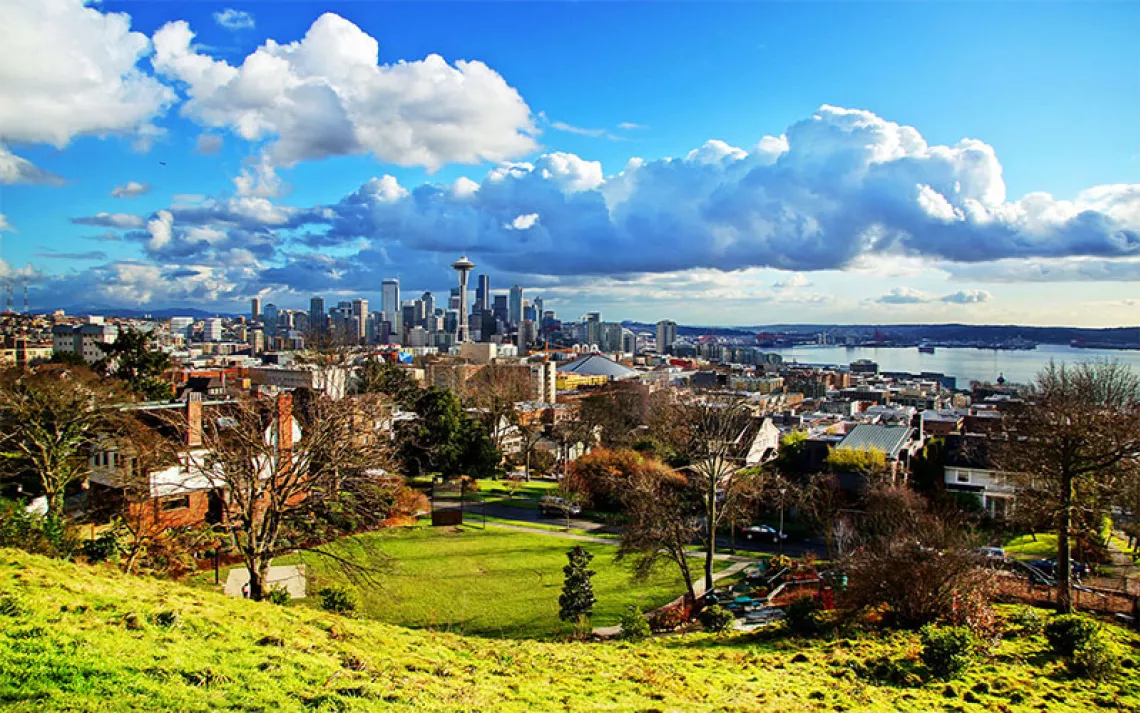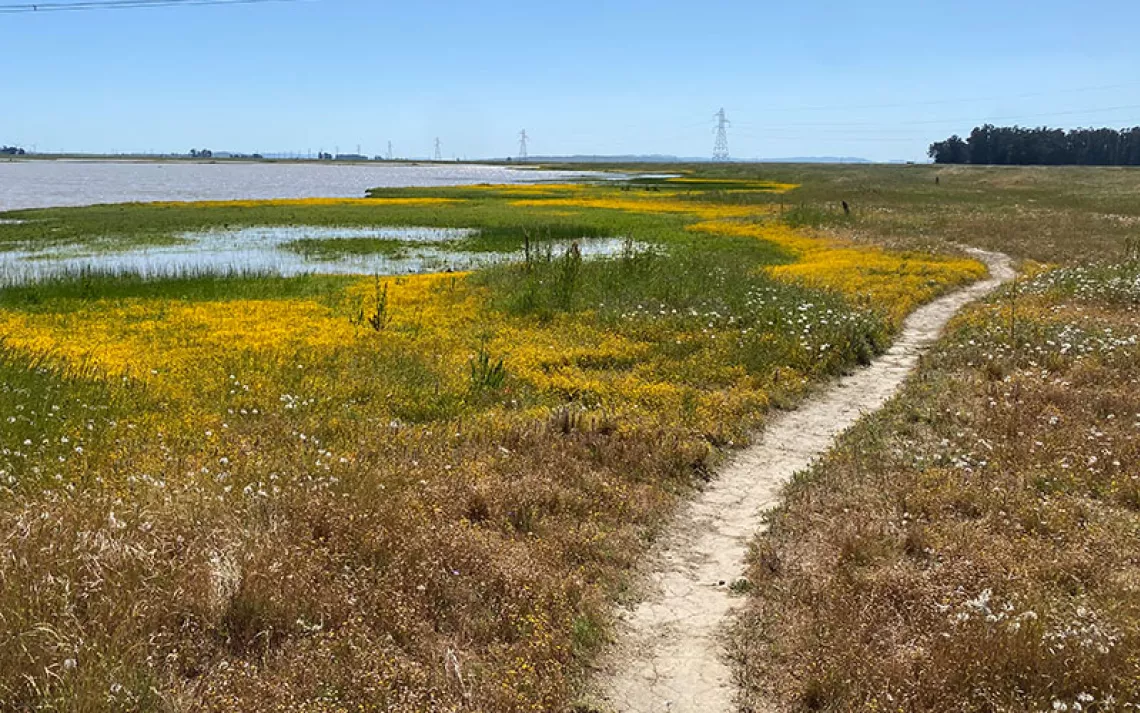Living Large Driving Less
What makes a community livable? How about getting rid of cars?

llustrations by John Blanchard
AT THE RISK OF SOUNDING LIKE YOUR GRANDFATHER, I am about to tell you how I walked to school when I was a kid. It may not have been three miles, through heavy snowdrifts (though, since I lived in Chicago, there were those), but on most days, I walked. It was just what most kids did.
I didn't grow up in a walking paradise--the Web site Walk Score rates my suburban childhood neighborhood a 38 out of 100 on the walkability scale, giving it the blunt designation "car-dependent." Yet my school was only a half mile away, and there were sidewalks, something that was beginning to seem superfluous--deemed too costly or simply unnecessary--to the new communities being built nearby. A tragic fait accompli was set in place.
That my own experience now smacks of an antique exoticism shows just how radically the American landscape has been altered in the past few decades: Our towns and cities cater to vehicles, not to people.

Sign up to receive Sierra News & Views
Get articles like this one sent directly to your inbox weekly.
With this action you affirm you want to receive Sierra Club communications and may vote on policy designated by the Sierra Club Board.
Schools provide one of the best examples. In the early 1970s, slightly more than half of all American children walked or biked to school; today, only 15 percent do. Some of that is attributable to fear, be it of "stranger danger" (although violent crimes per capita have dropped since the 1970s) or of traffic itself (even though vehicle accidents are the leading cause of death in children). And in many cases, new schools are simply too far from homes. In 1969, roughly half of all children lived a mile or more from their school; by 2001 three out of four did.
To imagine a foot-friendly approach, consider the P. L. Robertson Public School in Milton, Ontario, which serves a relatively dense new subdivision in suburban Toronto. Robertson, where virtually all students live within the one-mile boundary deemed walkable, was planned with the ambitious goal of being a "walk-only" school.
Despite the students' physical proximity to the school, getting them to walk there was no easy task, according to Jennifer Jenkins, who works with Canada's Active and Safe Routes to School program. It wasn't just a matter of adding sidewalks and bike racks near the school, or establishing no-stopping zones to discourage car drop-offs.
Jenkins says it was about shifting behavior: "We're trying to change the social norm from driving to walking." That her program--which essentially teaches children and parents how to walk to school--even exists, she says, is "kind of scary."
Other sweeping changes have rolled through our towns and cities since my childhood. Between 1969 and 2001, the number of vehicle miles traveled--how much the average American drives in a given year--increased more than 150 percent. It's as if our romance with the car has turned into a dependency. What's more, this isn't solely about commuting (which represents only 14.9 percent of all trips taken) but also about "discretionary" driving--optional car trips that we're increasingly coming to see as necessary. McDonald's, for example, began opening drive-throughs at its restaurants in the mid-1970s. The chain now derives 65 percent of its revenues from them.
Compare vehicle miles traveled over the past few decades with American obesity rates during the same period. You will see that they both began to spike upward at the same time and continue to rise in lockstep. A study published in the American Journal of Preventive Medicine found that male residents of Salt Lake City who lived in walkable (denser and older) sections of town weighed an average of 10 pounds less than those who lived in less-walkable (spread out and newer) sections.
All that extra driving--people using a gallon of gas to get a gallon of milk--has turned us into high-octane petro-vores. Between 1960 and '70, the U.S. population grew by 13 percent while gasoline demand rose by 54 percent; the next decade, with the same population growth, gas demand increased by 17 percent.
The shift to sprawling development patterns and the turning away from once-common practices like walking to school are often defended as a matter of "choice"--one, of course, fueled by decades of government laws and incentives. The irony is that many communities today have no choice when it comes to transportation: We have created a vehicular monoculture. But there are signs that this is changing. First, we seem to be maxing out on just how much driving we're willing to do.
THE TOTAL NUMBER OF VEHICLE MILES TRAVELED DROPPED in 2007 for the first time since 1980. Another sign of change comes from the government. In what it called a "transformative policy shift," the U.S. Department of Transportation announced in 2009 that it would work to foster "livable communities," which were memorably summed up by Secretary Ray LaHood: "Livability means being able to take your kids to school, go to work, see a doctor, drop by the grocery or post office, go out to dinner and a movie, and play with your kids at the park--all without having to get in your car."
This idea of "livability" was immediately subjected to political scrutiny. What was it, and who was the government to decide how people should live? Of course, government already tells people how to live, through zoning regulations. Such laws prevent a chemical plant from setting up camp next to your cul-de-sac, but they may also prevent developers from building denser, pedestrian-friendly neighborhoods in areas used to expansive lots. Even in my own walkable, transit-stocked neighborhood in Brooklyn (whose Walk Score rating is 98), new housing developments are required to add costly parking facilities. And studies show that guaranteed parking places, not surprisingly, lead to more driving.
So, "livability" is a fine program for big cities, but what about smaller communities? As Missouri senator Kit Bond notes, he's "got a lot of constituents for whom livability means having a decent highway." But Beth Osborne, assistant secretary of the Transportation Department, notes that livable-communities programs can benefit towns and smaller cities, citing the department's efforts to restore neglected Main Streets in Missouri and install traffic-relieving trolleys in Maine.
Too often, livability is narrowly defined by such things as house size or price. By this measure, New York City "may be the most unlivable city in the United States," rail and smart-growth opponent Wendell Cox argues. But people tend to downplay how they're getting to that house. As the Center for Neighborhood Technology has shown in its studies of Chicago, the affordability of housing in farther-flung areas is eaten away by higher transportation costs. Not that city dwellers have to renounce cars: Car-sharing programs allow planners to talk about vehicle miles not traveled.
Transportation planner Ian Lockwood once told me he thought it was curious that when people described ideal vacation destinations, they were always, in essence, "livable" communities--whether the Main Street of Disney World or the mossy squares of Savannah, Georgia. Why, then, he asked, do they not seem to want to live that way? But consider the housing market in Denver: According to one report, the value of homes within a half mile of a light-rail station rose by 17.6 percent between 2006 and 2008, while the value of those in the rest of the city dropped by an average of 7.5 percent. The National Association of Realtors, in an April survey of prospective home buyers, found that 77 percent of home shoppers "would look for neighborhoods with abundant sidewalks and other pedestrian-friendly features."
For too long, we've let livability take a backseat to mobility, with negative consequences for health, community strength, and the environment. The projects on these pages show how a sense of balance can be restored. Someday, you may be telling your grandchildren how you used to be driven five traffic-clogged miles to school every day, and they'll shake their heads in wonder.
With enough willpower, many of us could abandon the family car for a bicycle, a sturdy pair of walking shoes, or public transit. But the effort is made much easier (and safer) if our communities lay the groundwork. Here are a few ways that cities, towns, and even rural areas can reduce our dependence on automobiles and their polluting fossil fuels.

HIGH-SPEED RAIL
Sleek trains that race between Los Angeles and San Francisco, Tampa and Orlando, and Milwaukee and Madison remain paper dreams, buffeted by reactionary politics and budgetary woes: $2.5 billion for high-speed rail was recently axed from the federal budget. But these energy-efficient substitutes for private vehicles and short-haul jets remain a great investment for the planet. California's proposed high-speed trains could reduce carbon dioxide emissions by 12 billion pounds per year by 2030.

LOCAL TRANSIT SYSTEMS
Efficient, reliable local transit is key to getting people out of cars. Nearly three dozen light-rail systems operate in North America today; Denver and Charlotte, North Carolina, have particularly good examples. "Bus rapid transit," in which buses run in dedicated lanes, is a low-cost alternative to building train lines. While not as efficient as trains, buses use significantly less energy per passenger mile than cars, provided the buses are at least half full. Simple programs pay off too: Redesigned routes and discounted bus passes dramatically increased ridership in Champaign-Urbana, Illinois (population 140,000).

INCENTIVES & FEES
Instead of giving the oil industry $4 billion in tax breaks every year, the United States could get financially creative and give people incentives to drive less. Also, offering tax breaks and rebates can steer them toward high-mpg cars. Other tactics include taxes based on annual miles driven and "congestion pricing" (charging higher tolls on crowded roadways and at in-demand parking meters). "Pay as you drive" insurance pricing also discourages driving by basing premiums on a vehicle's annual mileage, a policy supported by the state of California to reduce traffic, pollution, and gasoline consumption. Mobility Choice, an organization focused on national-security issues posed by oil dependence, proposes that an "oil security fee" be levied per barrel or at the fuel pump.

SMART GROWTH
While auto-dependent sprawl shaped the U.S. landscape over the past 50 years, policies that encourage "smart growth" and transit-oriented development seek to put people ahead of cars. Zoning laws that allow denser communities and a mix of residential and commercial uses adjacent to transit hubs make automobiles accessories rather than necessities. For example, at Sacramento Senior Homes in Berkeley, California, 40 residential units were built above ground-floor retail spaces, all adjacent to public transportation--and with solar panels on the roof to boot.
COMPLETE STREETS
Why not design streets for everyone who uses them, not just drivers? That's the thinking behind "complete streets" policies: roads should be made safe for, and attractive to, pedestrians, cyclists, and public-transit patrons. The National Complete Streets Coalition (completestreets.org) includes AARP, the American Heart Association, and environmental groups. Club activists recently helped pass complete streets policies in Minnesota, Dubuque, Iowa (population 57,000), and South Kingston, Rhode Island (population 30,000).

PEDALERS & PEDESTRIANS
Designing bike- and pedestrian-friendly infrastructure helps reduce vehicle miles traveled on a large scale and affects residents on an immediate and personal scale. Sierra Club activists recently persuaded Minneapolis officials to stripe two critical corridors for bike lanes to make commuter cycling more appealing. Capital Bikeshare (capitalbikeshare.com) provides a fleet of 1,100 bicycles at 110 transit stations around Washington, D.C. In Memphis--which has a 34 percent obesity rate--a network of walking and biking trails called Greenline connects neighborhoods with downtown and helps residents stay healthy.
HIGH-MILEAGE ROLLERS
When you're paying around $4 a gallon for gas, wouldn't you like your car to get 60 miles a gallon? The Sierra Club has joined a coalition of organizations to urge federal lawmakers to establish that fuel-efficiency standard, which would cut U.S. oil dependence by at least 49 billion gallons in 2030. At the same time, new greenhouse-gas pollution standards could reduce heat-trapping carbon pollution by 535 million metric tons. Automakers can reach those goals affordably by using lighter materials as well as off-the-shelf technologies like direct injection, dual-clutch transmissions, and stop-start technology, which shuts off an engine when the vehicle isn't moving. For more information, check out go60mpg.org.
 The Magazine of The Sierra Club
The Magazine of The Sierra Club



